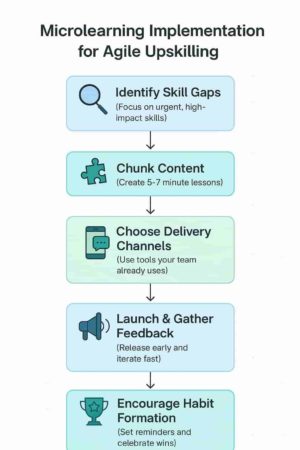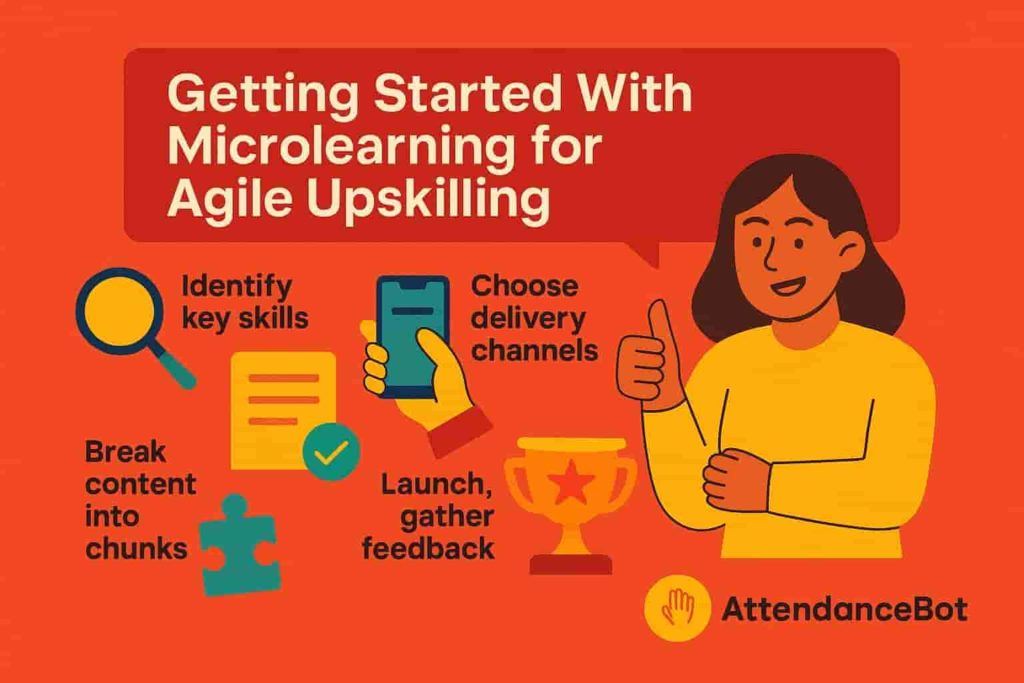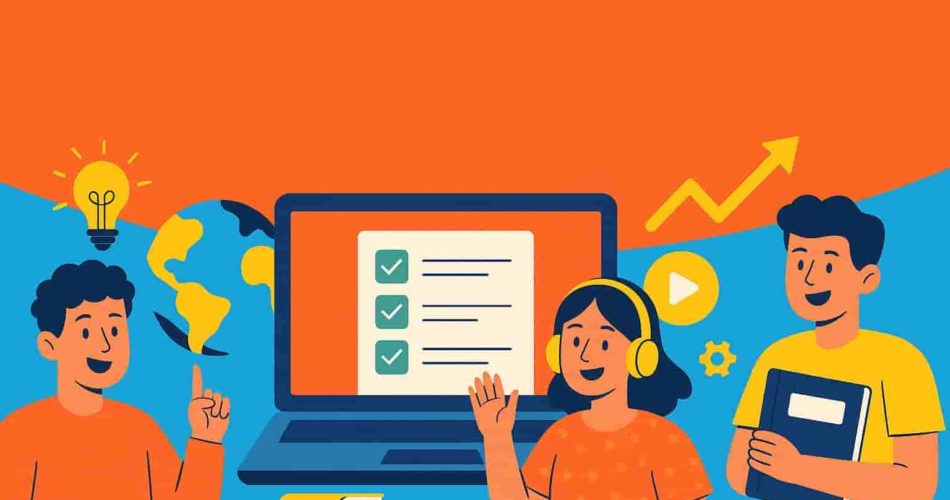When your team is scaling fast and responsibilities are constantly shifting, traditional training programs often fall short. No one has time to sit through lengthy modules, yet everyone needs to keep pace with new tools, evolving workflows, and growing expectations. That’s where microlearning comes in—a flexible, focused way to embed agile training into the everyday flow of work. It’s not just about speed; it’s about creating a culture of continuous upskilling without burnout. Whether you’re onboarding new hires, upskilling existing team members, or preparing for the next big shift, this bite-sized approach can help your people learn quickly, apply immediately, and stay ahead, without stepping away from their core work for hours on end.
What Is Microlearning and Why Does It Work?
Microlearning is exactly what it sounds like—short, focused learning experiences designed to deliver specific knowledge or skills in minutes, not hours. Think of a quick how-to video, an interactive quiz, or a checklist embedded in Slack. These are practical, accessible, and designed to be consumed during natural breaks in the day. For growing companies, where employees wear many hats and priorities shift fast, microlearning offers a way to stay sharp without derailing productivity.
The power of microlearning lies in how well it supports agile training. You’re not planning massive courses that take months to develop and deploy. Instead, you’re delivering fast, relevant content that meets people where they are—whether it’s learning a new feature in your CRM, brushing up on negotiation techniques, or adapting to a fresh project management framework. This agility ensures training evolves in sync with your business.
More importantly, microlearning fuels a mindset of continuous upskilling. It encourages people to learn often, not just when it’s scheduled. Over time, these bite-sized moments compound into big gains, creating teams that adapt faster, stay curious, and drive results without ever feeling overwhelmed.
How to Build a Microlearning Strategy for Agile Upskilling
If you’re responsible for training a fast-moving team, you don’t need more complexity—you need clarity. Here’s how to create a simple, effective microlearning strategy that supports both agile training needs and long-term, continuous upskilling goals.
1. Identify Skills That Matter Now
Start with what’s changing. Are new tools being adopted? Are roles evolving as your team grows? Focus your microlearning on high-impact skills—things people need to do their job better today, not someday. This keeps training relevant and instantly useful.
2. Break Down Big Topics into Small Wins
Take a skill like “effective client communication” and split it into bite-sized pieces: writing better emails, handling objections, and following up with clarity. Each sub-topic becomes a quick, standalone microlearning module. These small wins are easier to fit into a busy workday and more likely to stick.
3. Deliver Training in the Flow of Work
To make microlearning work, bring it where your people already are—Slack, Microsoft Teams, or your project management tool. A five-minute lesson delivered via a Slack bot right before a team meeting? That’s smart agile training. It removes friction and builds learning into routines.
4. Mix It Up: Formats and Frequencies
Some people learn best through videos, others prefer checklists or short quizzes. Use a variety of formats and keep sessions short—five to 10 minutes max. Spread these out across the week instead of cramming them into one sitting. That’s how continuous upskilling becomes habit, not homework.
Look at completion rates, feedback, and on-the-job performance. Which modules are people engaging with? Which skills are they applying? Use that data to adjust and improve your strategy. The beauty of microlearning is how easy it is to pivot, just like your business.

Microlearning in Action: Real Examples for Busy Teams
You don’t need a big LMS rollout or fancy production tools to get started with microlearning. The best ideas are simple, scalable, and quick to implement. Here are some examples teams are using right now:
- Daily Slack Tips: A five-minute read or GIF-based explainer about time-saving shortcuts, customer response techniques, or updated tools—delivered automatically via a Slack bot. It’s a great way to integrate microlearning into the tools your team already uses.
- Interactive Checklists: Built into platforms like Notion, Trello, or Asana, checklists help walk employees through repeatable tasks like onboarding clients or submitting reports—step by step and stress-free.
- Two-Minute Explainer Videos: Short clips hosted on platforms like Loom or Vimeo offer visual learners an easy way to digest a new tool or process without the need for a full training session.
- Weekly Micro-Challenges: Use team spaces in Microsoft Teams or Slack to run quick challenges. For example: “Give one teammate constructive feedback this week and share what worked.”
- Quick Quizzes in Email: Use tools like Google Forms, Typeform, or Quizlet to send scenario-based micro-assessments that reinforce core skills without feeling like a test.
These real-world use cases prove that microlearning isn’t just about convenience—it’s about creating consistent, agile, and impactful learning moments using the tools your team already lives in.
Agile Training: A Smarter Way to Keep Up With Change
In growing businesses, change is the only constant. Processes shift, roles stretch, and new tools get adopted faster than anyone can document them. Traditional training models struggle to keep up, and that’s where agile training comes in.
Why Agile Upskilling Works for Fast-Moving Teams
Agile training doesn’t rely on fixed curricula or long development cycles. Instead, it mirrors the iterative approach your product or engineering teams already use: rapid delivery, regular feedback, and continuous improvement.
- Spot a need → create a quick training asset
- Test it with a small group
- Improve based on feedback
- Scale it if it works
It’s training that evolves with your business instead of lagging behind it.
Microlearning: The Engine Behind Agile Training
Microlearning makes agile training possible. Because lessons are short and focused, they’re easier to create, test, and update. Instead of holding people back while you build a full course, you can release a bite-sized lesson today and improve it tomorrow.
You’re not aiming for polish—you’re aiming for progress. A quick process walkthrough, a single-page how-to, or a five-question quiz can be more effective than a 90-minute webinar. It’s not about less content. It’s about smarter content, designed for right-now relevance.
Continuous Upskilling: Building Learning Into the Culture
Training to solve immediate needs is important, but so is thinking long-term. That’s where continuous upskilling comes in. It’s about giving people the habits, tools, and encouragement to keep growing, even when there’s no urgent requirement.
What It Looks Like Day-to-Day
While agile training is reactive, continuous upskilling is proactive. You’re not just plugging skill gaps—you’re future-proofing your team. But this doesn’t mean pushing people into more formal learning. It means supporting consistent, meaningful engagement over time.
- Employees reflect on what they learned weekly
- Managers nudge growth with coaching prompts
- Teams share knowledge during project debriefs
- Short lessons are built into recurring workflows
All of this can be powered by microlearning, because it’s low effort and high frequency. People don’t need to stop working to grow—they learn while doing.
Upskilling Is Everyone’s Job—Not Just HR’s
Another shift? Moving from top-down learning plans to shared learning ownership. With continuous upskilling, employees are encouraged to pull learning based on their interests and goals, not just wait to be pushed content.
That might mean surfacing skill-building opportunities during 1:1s. It might mean giving team leads micro-resources they can embed in standups. The role of L&D becomes less about delivering content and more about enabling everyday learning behavior.
Why Microlearning Ties It All Together
You’ve seen it now—microlearning isn’t a tactic. It’s a foundation. It enables agile training by making lessons fast and flexible. It powers continuous upskilling by embedding small learning moments into the flow of work.
For companies growing fast and changing often, this model works because it’s not disruptive. It’s steady. It’s personalized. And most importantly, it respects your team’s time.
A Few Final Reminders:
- Think iteration, not perfection
- Prioritize momentum over length
- Make learning easy to access and even easier to apply
- Look for ways to pair learning with real work, not pull people away from it
The future of learning at work isn’t a classroom. It’s a daily habit. Microlearning makes that habit easy to build and even easier to scale.
Getting Started With Microlearning for Agile Upskilling

Launching a microlearning program can feel overwhelming, but breaking it down into simple steps helps you build momentum without stress. Here’s a straightforward path to kick off agile training and support continuous upskilling on your team.
1. Identify Key Skill Gaps and Priorities
Start by pinpointing the most urgent skills your team needs to develop. Focus on areas where quick learning can unlock immediate impact. This focus makes your agile training efforts efficient and targeted.
2. Break Content Into Small, Focused Chunks
Transform broad topics into bite-sized lessons that take no more than 5-7 minutes to complete. Short bursts of learning fit into busy schedules and help build consistent, continuous upskilling habits.
3. Choose Delivery Channels That Fit Your Team
Whether it’s Slack messages, mobile apps, or quick videos, pick platforms your team already uses daily. Seamless integration ensures your microlearning reaches people where they work, making it easier to adopt.
4. Launch, Gather Feedback, and Iterate Fast
Release your first microlearning modules quickly and invite feedback from learners. Use this input to tweak content and delivery. This loop embodies agile training—continuous improvement over perfection.
5. Encourage Habit Formation and Recognition
Support your team in making learning a regular habit by setting reminders or embedding short challenges in workflows. Celebrate progress to reinforce the value of continuous learning and maintain high motivation.

Keep It Small, Keep It Smart: The Future of Learning Is Micro
For growing teams and busy professionals, the old model of hours-long courses just doesn’t fit anymore. That’s why microlearning isn’t just a buzzword—it’s a strategic shift toward smarter, more adaptable skill-building. When paired with agile training methods and a mindset of continuous upskilling, it helps teams learn in ways that stick, without slowing down the pace of work.
Whether you’re helping your team adopt new tools, navigate evolving roles, or simply build a stronger learning culture, small moments of training can lead to big results. Microlearning creates space for learning to happen naturally, inside the flow of work, not outside it.
So if you’re looking to upskill your team quickly, support fast-moving growth, and build a culture of everyday learning, this is your starting line.



